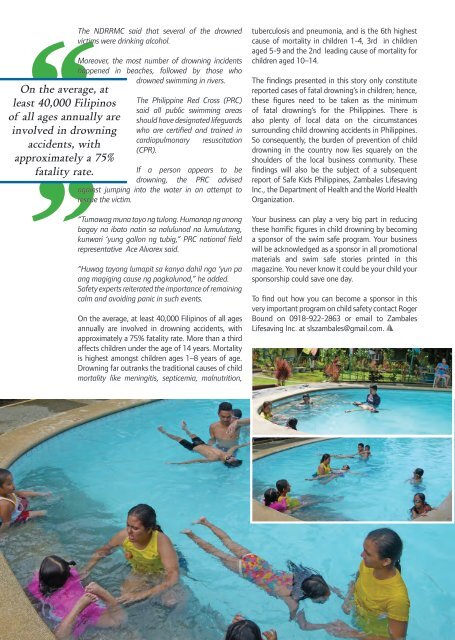ABW June 2018
Create successful ePaper yourself
Turn your PDF publications into a flip-book with our unique Google optimized e-Paper software.
On the average, at<br />
least 40,000 Filipinos<br />
of all ages annually are<br />
involved in drowning<br />
accidents, with<br />
approximately a 75%<br />
fatality rate.<br />
The NDRRMC said that several of the drowned<br />
victims were drinking alcohol.<br />
Moreover, the most number of drowning incidents<br />
happened in beaches, followed by those who<br />
drowned swimming in rivers.<br />
The Philippine Red Cross (PRC)<br />
said all public swimming areas<br />
should have designated lifeguards<br />
who are certified and trained in<br />
cardiopulmonary resuscitation<br />
(CPR).<br />
If a person appears to be<br />
drowning, the PRC advised<br />
against jumping into the water in an attempt to<br />
rescue the victim.<br />
“Tumawag muna tayo ng tulong. Humanap ng anong<br />
bagay na ibato natin sa nalulunod na lumulutang,<br />
kunwari ‘yung gallon ng tubig,” PRC national field<br />
representative Ace Alvarex said.<br />
“Huwag tayong lumapit sa kanya dahil nga ‘yun pa<br />
ang magiging cause ng pagkalunod,” he added.<br />
Safety experts reiterated the importance of remaining<br />
calm and avoiding panic in such events.<br />
On the average, at least 40,000 Filipinos of all ages<br />
annually are involved in drowning accidents, with<br />
approximately a 75% fatality rate. More than a third<br />
affects children under the age of 14 years. Mortality<br />
is highest amongst children ages 1–8 years of age.<br />
Drowning far outranks the traditional causes of child<br />
mortality like meningitis, septicemia, malnutrition,<br />
tuberculosis and pneumonia, and is the 6th highest<br />
cause of mortality in children 1-4, 3rd in children<br />
aged 5-9 and the 2nd leading cause of mortality for<br />
children aged 10–14.<br />
The findings presented in this story only constitute<br />
reported cases of fatal drowning’s in children; hence,<br />
these figures need to be taken as the minimum<br />
of fatal drowning’s for the Philippines. There is<br />
also plenty of local data on the circumstances<br />
surrounding child drowning accidents in Philippines.<br />
So consequently, the burden of prevention of child<br />
drowning in the country now lies squarely on the<br />
shoulders of the local business community. These<br />
findings will also be the subject of a subsequent<br />
report of Safe Kids Philippines, Zambales Lifesaving<br />
Inc., the Department of Health and the World Health<br />
Organization.<br />
Your business can play a very big part in reducing<br />
these horrific figures in child drowning by becoming<br />
a sponsor of the swim safe program. Your business<br />
will be acknowledged as a sponsor in all promotional<br />
materials and swim safe stories printed in this<br />
magazine. You never know it could be your child your<br />
sponsorship could save one day.<br />
To find out how you can become a sponsor in this<br />
very important program on child safety contact Roger<br />
Bound on 0918-922-2863 or email to Zambales<br />
Lifesaving Inc. at slszambales@gmail.com.<br />
48


















